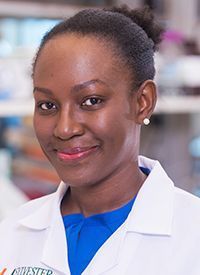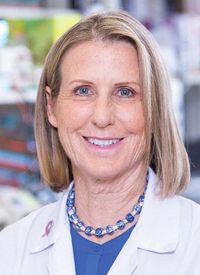Article
Bringing Individualized Care to Patients With Breast and Ovarian Cancers in the Caribbean
Author(s):
Current breast cancer screening practices in the Caribbean exclude the majority of the younger patient population, thereby leaving many cases of breast cancer undiagnosed.
Sophia George, PhD

Current breast cancer screening practices in the Caribbean exclude the majority of the younger patient population, thereby leaving many cases of breast cancer undiagnosed, according to Sophia George, PhD, and Judith E. Hurley, MD.
“Most of these countries, for very good reasons, are following the American Cancer Society guidelines for screening, which [are effective] in the United States where the average age of the breast cancer patient is 62 years,” Hurley, who is an oncologist at Jackson Memorial Hospital, explained. “[However], they do not work in a country where the average age [for breast cancer] is 48 years. If you are missing 20% or 30% of your patients with the screening program that you are using, that is not a good screening program.”
George, who is a research assistant professor at Sylvester Comprehensive Cancer Center of the University of Miami Health System, added, “This is a conversation that we [need to] have [with] people in the Caribbean, but as Dr Hurley said, we have many West Indians and people from the Caribbean here in the United States. As we move here, our breast cancer [diagnoses are] shifting a little bit [because] we're in a different environment. For breast cancers, diagnoses [are happening] a little bit later, but still younger than the average age of diagnosis in the United States.”
In a recent paper, George and Hurley found that 1 in 7 Caribbean-born individual with either breast or ovarian cancer had hereditary disease with an actionable pathogenic variant, which provides the opportunity for targeted therapies and unique prevention approaches. Each island was very unique, even in the types of breast cancer and genetic mutations that were observed. Although that is an important observation in the Caribbean, it is also important in the United States; “when [people] emigrate to another country, [they] bring [their] genes with them,” Hurley noted.
In an interview with OncLive®, George and Hurley discussed the need to create unique screening programs tailored to each island in the Caribbean, to focus screening efforts on Caribbean women in the United States, and to examine the impact of immigration on breast cancer risk.
Judith E. Hurley, MD

OncLive®: Was there anything about the study results that you found to be surprising?
Hurley: I was shocked at how [distinct] each island was. You cannot extrapolate [data] from island to island; each is quite unique. The big push in the United States is personalized medicine. This [study examines the opportunity for] personalized medicine on a country-by-country level.
I was also shocked at the percentage of patients who were self-diagnosed; that was really illuminating. It speaks to [the fact] that you have to change the way screenings happen because screenings are not happening in a successful fashion.
Compared with the United States, the Caribbean has a high incidence of stage III and stage IV [disease]. If you do not have a screening [approach] that is working, the first step is to try to downstage the patients in terms of when they notice their lumps. If the person who notices the lump is going to be the individual, then you have to start moving them from something the size of a grapefruit to something the size of a grape; you save a lot of lives just by doing that. However, that is a whole sociological shift that has to happen. Women just have to be more comfortable with looking for it, be told that it is okay, and find a way that is socially acceptable to do it.
George: One of the things I talk about often is [that] we found that 14.2% of the people who participated [on the study] had a mutation, but that means that 85.8% in general did not. For the Bahamas, that is 25% who had a mutation, so 75% did not; [those patients] are still very young. What does that mean in the context of screening? Even being [in the United States], it means that [many] will be below the age before [they would] actually go into the screening programs. [As such,] I talk [to my patients] about touching [their] breasts and [being] aware of the lumps in [their] breasts, because of higher rates of breast cancer diagnosis.
Could you expand on the importance of individualizing care in this population?
Hurley: Each island is going to have to develop their own screening program [and determine] what works for them. However, because the incidence of inherited breast cancer is so high in the Bahamas, we went back and screened women who did not have breast cancer, with just 2000 people at the supermarket. If they had any family history at all—it did not have to be a first or second degree relative—3% of those women had a deleterious mutation. If they had no family history, [the presence of this mutation] was way less than 1%.
By a simple screening test like that, you pull out your very high–risk people, but 3% of the population is a big number. If you know about that, then you can start to mitigate; you can empower those women to take preventive measures and go onto a very different screening pattern. Individualized medicine is possible when you generate data like these. Of course, we generated more questions than we answered though.
What are some of those questions that still need to be addressed?
Hurley: Twenty-three percent of the Bahamians had inherited breast cancer, but 77% did not. [For] those without a mutation, the average age of breast cancer was 48 years. There is still a problem and we do not really know what it is.
We are also very interested in what is happening in Miami, Florida, too, because you bring your genes and you bring your risk with you [when you immigrate], but your risk gets changed, so we are really interested in the effect of immigration on breast cancer risk. It started with the Haitian women, as [we see that] their breast cancer age and stage were completely different than the Haitian immigrants in Miami. How does this even happen? The average age of an immigrant from Haiti in Miami is 41 years. It is not like they came after they were diagnosed, it is still before the average age of breast cancer in Haiti. How does their risk change? We are expanding into the epigenetic field because those things that modify your DNA in a short-term fashion can impact your risk of breast cancer. We are very interested in the effect of immigration; how coming to a new country, new diet, new exposures, and high levels of stress, can impact breast cancer [risk].
What was found regarding patients with ovarian cancer on the trial?
George: We would recruit study participants with our colleagues and collaborators; it was very much a ground-up partnership way that we did this. In every country, we had oncologists, gynecologic oncologists, or medical oncologist participating with us. We were not able to recruit as many patients with ovarian cancer as we wanted because this is a very deadly disease. The majority of study participants who were diagnosed with ovarian cancer [had] high-grade serous ovarian cancer; they were young [at] about 50 to 51 years. Those who have a mutation vs those who did not have a mutation actually seemed younger, [although] it is a small study sample. We know that having a BRCA mutation and having ovarian cancer means that, in the best setting, you have access to targeted therapy.
[For these] women, if it were in a different space and they had access to PARP inhibitors, that would be great. For me, the most important thing is prevention; it is knowing the mutation and that you are at a higher risk for having them. [It is important to] be aware of family history, the mitigating factors that you can [consider], and steps that you can take to prevent ovarian cancer, particularly in a population where the disease is very aggressive, even in the United States, with black women having worse outcomes.
Hurley: Going forward, we are adding endometrial cancer into these [studies] because the [presence of the] BRCA1 and BRCA2 [mutation] do seem to predispose patients to a particularly aggressive form of endometrial cancer. Our future is in women's cancers, not [including] cervical cancer.
George: We are working with a highly collaborative, multidisciplinary team, where, in addition to identifying women who are at high risk for developing these diseases, we [are trying to understand what we] can do to help mitigate risk. It is really a comprehensive approach that we are taking with our collaborators, epidemiologists, gynecologic oncologists, medical oncologists, translational basic scientists like myself, and even behavioral scientists.
We did a study in Trinidad asking, 'Well, once we give the study participants the results, what did they do with the information?' Those who came, participated, and who had breast cancer did do something, but with those who did not, the family members did very little. We have a lot of work that we need to do in the context of understanding what prevention looks like in this space.
Where should future research efforts be focused?
Hurley: In addition to the immigration and the epigenetics that we are interested in, we have become very interested in comparing and contrasting Black American women with breast cancer vs Caribbean women with breast cancer and Caribbean American women with breast cancer. We found things that we found to be surprising. For example, Black American women, when you match them stage for stage with our Caribbean American women, do much worse. The immigrants do better, which is fascinating and unexpected.
Why is that? We are thinking that it may be the results of years of racism. [Having] that stress your entire life impacts everything, including health outcomes. We already know it impacts health outcomes, but it may impact it in such a dramatic measure that when you match black woman from outside the country who lived in our country with black women who were raised in our country, women from the Caribbean do better. We are very interested [to learn more about that].
George: Because we have a large Caribbean immigrant population in the United States, while Caribbean women do better, I suspect it is not every group. Unfortunately, there is a history of ‘otherism’ with Haitian immigrants, but we see that they do not benefit from doing better. Of course, this is all hypothesis, but a lot of data support that. It could be linked to differences in language, but also, I would say [it can be linked to] classism and the stigma of different aspects of being Haitian in America.
I am as a West Indian American scientist here in Miami, trying to [participate in] work to try to disaggregate and appreciate that there are differences. At the end of the day, when we walk into a clinic or [participate on] a study, we all look the same phenotypically; however, we know that there are differences in experience and outcomes. How do we, with the work that we are doing, lift everyone so that we have better outcomes and better prevention strategies? How do we interact with our communities to [best] use this information that we are generating, and to improve health outcomes?
Hurley: The black population in the United States is not monolithic. There appear to be disparities, inside of disparities, inside of disparities. We [need to] keep working on those different disparities and try to find reasons for them and ways to eliminate them.
Reference
- George SHL, Donenberg T, Alexis C, et al. Gene sequencing for pathogenic variants among adults with breast and ovarian cancer in the Caribbean. JAMA Netw Open. 2021;4(3):210307. doi:10.1001/jamanetworkopen.2021.0307









